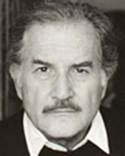discovered the face of a woman that was mine, of my blood, of my memory, Laura Diaz, grandmother of my father, murdered in Tlatelolco, mother of another Santiago who couldn’t fulfill his artistic promise but who perhaps transmitted to his grandnephew the continuity of the artistic image, sister of a first Santiago shot in Veracruz and delivered to the waves in the Gulf of Mexico.
Now, here, in Los Angeles, the American Babel, Byzantium of the Pacific, the utopia of the new century, I was finishing a chapter in my artistic and family inheritance, the chronicle that Enedina and I had decided to call
“Is there anything more to say?” Enedina asked me that night, as we embraced, naked, in our Santa Monica apartment near the murmuring of the sea.
Yes, no doubt there was always something more, but between the two of us, almost brother and sister from childhood, but absolute lovers, each one belonging to the other, no explanations asked, from the time we arrived in California as infants and then grew up together, went to school together, studied together at UCLA and became impassioned by our courses in philosophy and history, on the Mexican Revolution, the history of socialism and anarcho-syndicalism, the workers’ movement in Latin America, the Spanish Civil War, the Holocaust, McCarthyism in the United States, studying the writings of Ortega y Gasset, Husserl, Marx, and Ferdinand Lassalle, seeing Eisenstein’s Mexican films and Leni Riefenstahl’s on Hitler’s glory and Alain Resnais on Auschwitz,
Speaking.
I’d had a concussion, dreamed wild dreams, had to stay in bed before getting back the use of my broken leg, but I didn’t forget my dreams, even when it took forever to regain the use of my leg.
Speaking.
Speaking with Enedina, recalling everything possible, inventing the impossible, freely mixing memory and imagination, what we knew, what we’d been told, what the generations of Laura Diaz knew and dreamed, the factual but also the possible, about their lives, the genealogy of Felipe Kelsen and Cosima Reiter, the sisters Hilda,, Virginia, and Maria de la O, Leticia (Mutti), and her husband, Fernando Diaz, the first Santiago, son of Fernando, Laura’s first ball at the San Cayetano hacienda, her marriage to Juan Francisco, the birth of the second Santiago and Danton, her love for Orlando Ximenez and for Jorge Maura, her devotion to Harry Jaffe, the death of the third Santiago at Tlatelolco, the liberation, the pain, the glory of Laura Diaz, daughter, wife, lover, mother, artist, old woman, young woman: Enedina and I remembered it all, and what we didn’t remember we imagined and what we didn’t imagine we discarded as unworthy of a life lived for the inseparable possibility of being and not being, of carrying through one part of existence by sacrificing another part and always knowing that nothing is totally possessed, neither truth nor error, neither wisdom nor memory, for we descend from incomplete but intense loves, from intense but incomplete memories, and we can only inherit what our ancestors bequeathed us, the community of the past and the will of the future, united in the present by memory, by desire, and by the knowledge that every act of love today carries out, in the end, the act of love begun yesterday. Today’s memory consecrated, as it deformed, the memory of yesterday. Today’s imagination was the truth of yesterday and tomorrow.
From our bed, Enedina and I stared for a long time at the painting of Adam and Eve ascending from Paradise instead of falling from Paradise, the painting of the first naked lovers, possessors of their own sensuality, created by the second Santiago, Santiago the Younger, before he died. Laura Diaz, in her will, had bequeathed the painting to us.
“I love you, Santiago.”
“And I love you, Enedina.”
“I love Laura Diaz a lot.”
“How wonderful that between the two of us we could recreate her life.”
“Her years. The years with Laura Diaz.”
Acknowledgments
THE BEST NOVELISTS in the world are our grandmothers, and it is to them I owe the first memory on which this novel is based. My maternal grandmother was Emilia Rivas Gil de Macias, widow of Manuel Macias Gutierrez; she born in Alamos, Sonora, he in Guadalajara, Jalisco; she the descendant of Spanish immigrants from Santander and, according to rumors I’ve heard, Yaqui Indians from Sonora. My grandfather Macias died tragically in 1919, leaving my grandmother with four young daughters-Maria Emilia, Selika, Carmen, and my mother, Berta Macias de Fuentes.
My paternal grandmother, Emilia Boettiger de Fuentes, was born in Catemaco, Veracruz, daughter of Philip Boettiger Keller, a German immigrant from Darmstadt, married to a young lady of Spanish origin, Ana Maria Murcia de Boettiger, with whom he had three daughters: Luisa (Boettiger de Salgado), Maria (Boettiger de Alvarez), and Emilia (Boettiger de Fuentes). Emilia married Rafael Fuentes Velez, president of the National Bank of Mexico in Veracruz and son of Carlos Fuentes Benitez and Clotilde Velez, who was attacked and mutilated on the stagecoach between Mexico City and Veracruz. A fourth Boettiger sister, Anita, was a mulatta, the issue of a never acknowledged love affair of my great-grandfather. She was always a confident and loving member of the Boettiger family.
My paternal grandparents had three sons, Carlos Fuentes Boettiger, my young uncle, a promising poet, disciple of Salvador Diaz Miron, and editor of the Xalapa magazine

But many other stories were told to me by two magnificent survivors of “the years with Laura Diaz,” Dona Julieta Olivier de Fernandez Landero, widow of the Orizaba industrialist Manuel Ferna ndez Landero, and Dona Ana Guido de Icaza, widow of the lawyer and writer Xavier Icaza Lopez-Negrete, who appears as a character in this novel. I have emotional and grateful memories of them both.
Finally, I began
London
August 1998
Carlos Fuentes



